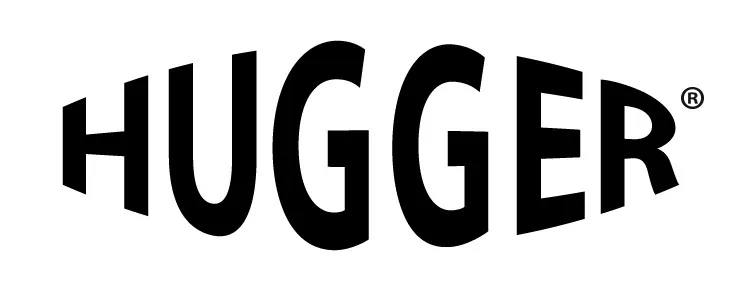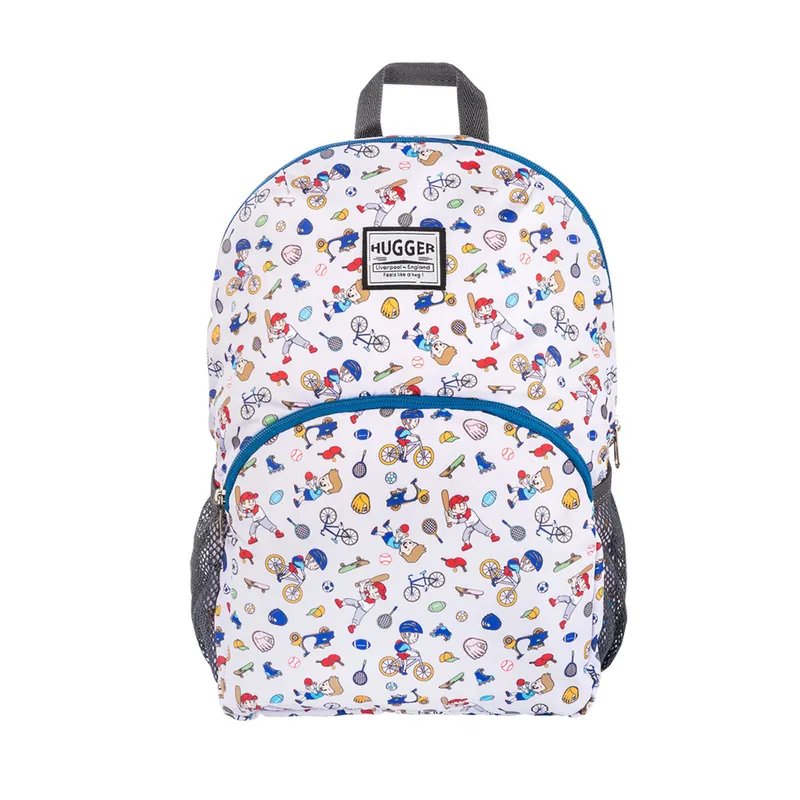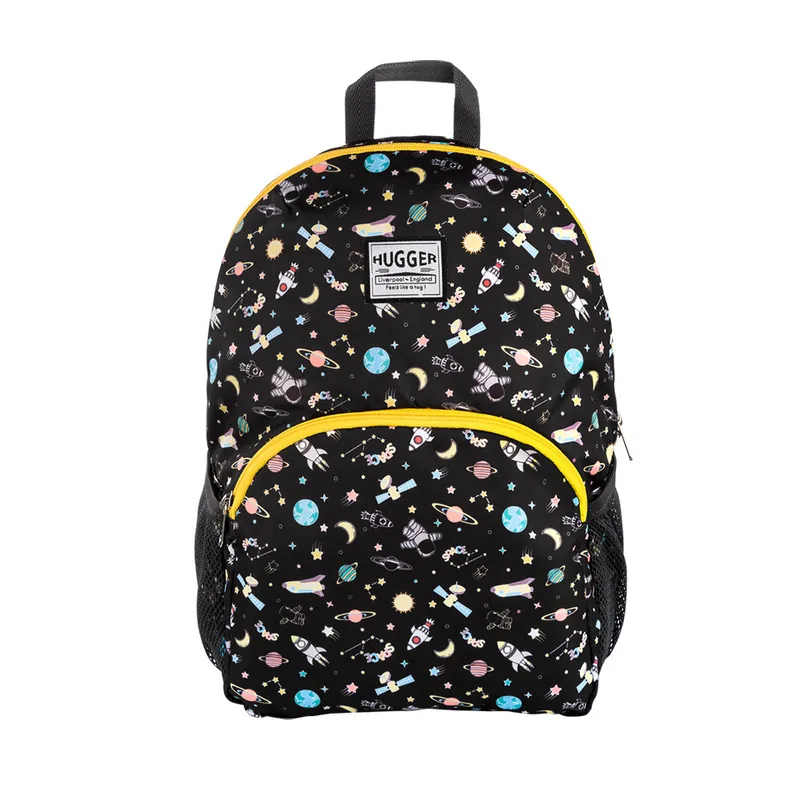When it comes to hiking with kids, having the right backpack is essential. Kids have different needs and requirements than adults when it comes to backpacks, so it’s important to choose one that is specifically designed for children. In this guide, we will explore the best hiking backpacks for kids, providing you with options that are durable, adjustable, and designed to meet the needs of young hikers.
Key Takeaways:
- Choosing the right backpack is crucial for kids’ comfort and safety while hiking.
- Look for adjustable-length torsos to account for their growth.
- Consider durability, storage space, and comfort features when selecting a backpack.
- Proper fit and weight distribution are important for a comfortable hiking experience.
- Ensure the backpack is packed correctly and regularly checked for adjustments.
Why Kids Need a Special Hiking Backpack
Buying a kid’s backpack is very different from buying an adult backpack because kids have smaller physical proportions. They also grow very quickly, so it’s important to choose a backpack that can be adjusted over time. A properly fitted backpack is crucial for comfort and safety while hiking. Additionally, a well-chosen, properly-packed backpack is a key factor in ensuring an enjoyable hiking experience for kids.
Kids hiking backpacks are specially designed to cater to the unique needs of young hikers. They are made with child-friendly materials that are lightweight yet durable, ensuring that the backpack can withstand the rigors of outdoor adventures. These backpacks often feature adjustable straps and torso length, allowing for a customized fit as the child grows. The padded shoulder straps and hip belts provide added comfort and help distribute the weight of the pack more evenly, reducing strain on their shoulders and back.
“A properly fitted backpack is crucial for comfort and safety while hiking.”
When hiking with kids, it’s important to consider their physical capabilities and limitations. Their smaller size and developing muscles make it more challenging to carry heavy loads. That’s why kids’ backpacks are designed to be lightweight yet spacious enough to carry all the necessary gear. They often feature multiple pockets and compartments for easy organization of essentials such as water bottles, snacks, and extra layers of clothing.
Investing in a durable and properly fitting hiking backpack for your child will not only ensure their comfort and safety but also enhance their overall hiking experience. It’s important to choose a backpack that suits their size, age, and physical abilities. By considering the features and details specifically designed for kids, you can provide them with the necessary gear to enjoy the great outdoors to the fullest.
Top Hiking Backpacks for Kids
When it comes to hiking with kids, having the right backpack is essential. Kids have different needs and requirements than adults when it comes to backpacks, so it’s important to choose one that is specifically designed for children. Below, we have compiled a list of the top 10 hiking backpacks for kids that are lightweight, durable, and designed with their comfort in mind.
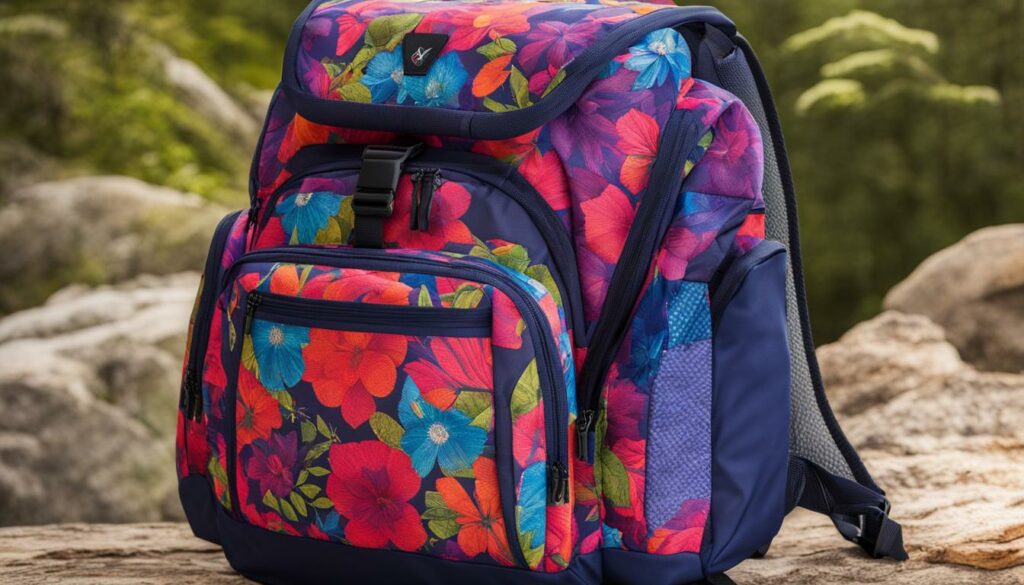
“HUGGER started from the British town of Liverpool in 2008 has finally traveled all over the world step by step.”
The HUGGER backpack, originating from Liverpool in 2008, has become a popular choice for kids’ hiking gear worldwide. Its lightweight design and durable construction make it an ideal companion for young hikers. With adjustable features and ample storage capacity, the HUGGER backpack provides comfort and convenience on the trails. Its success is a testament to its quality and reliability.
So if you’re in search of the perfect hiking backpack for your child, consider one of these top 10 options. Their lightweight designs, durable construction, and kid-friendly features make them the ideal choice for children’s hiking gear. Invest in a backpack that will keep your child comfortable, organized, and excited for their next outdoor adventure.
Choosing the Right Size for Kids’ Backpacks
When it comes to selecting a hiking backpack for kids, finding the right size is crucial for their comfort and overall hiking experience. Most kids’ backpacks come in various sizes, typically measured by torso length. To ensure a proper fit, it’s important to determine your child’s torso length by measuring from the base of the neck to the top of the hip bone.
By taking this measurement, you can choose a backpack that fits your child’s body properly, allowing for proper weight distribution and minimizing strain on their shoulders and back. Keep in mind that a backpack that is too large or too small can lead to discomfort and potential injuries while hiking.
When shopping for a child-friendly hiking backpack, look for those that offer adjustable torso lengths, allowing you to customize the fit as your child grows. This feature ensures that the backpack can accommodate your child’s growth spurts, providing a proper and comfortable fit throughout their hiking adventures.
| Torso Length Range (in inches) | Recommended Backpack Size |
|---|---|
| 12-14 | XS |
| 14-16 | S |
| 16-18 | M |
| 18-20 | L |
| 20-22 | XL |
Remember, choosing the right size backpack for your child is essential for their comfort and enjoyment on the trails. Measure their torso length, and opt for a backpack that offers adjustability and a proper fit to ensure a positive hiking experience.
Weight Considerations for Kids’ Backpacks
When it comes to choosing a hiking backpack for kids, weight is an important factor to consider. A heavy backpack can cause discomfort, fatigue, and strain on young hikers. To ensure a pleasant hiking experience for your child, it’s essential to pay attention to the weight of the backpack and the load they will carry.
The general rule of thumb is to limit the weight of the backpack to 10-15% of your child’s body weight. This includes both the weight of the pack itself and the contents. By sticking to this guideline, you can prevent your child from being overwhelmed and ensure they can comfortably carry their essentials on the trail.
When choosing a backpack for your child, opt for lightweight backpacking gear specifically designed for kids. These backpacks are made with lightweight materials without compromising on durability. They are designed to provide ample storage space while keeping the overall weight down.
Remember, a lighter backpack means less strain on your child’s body, allowing them to fully enjoy their hiking experience. Prioritize lightweight backpacks when selecting gear for your young hiker, and ensure they have a comfortable and enjoyable time on the trails.
Key Features to Look for in Kids’ Backpacks
When choosing a backpack for your child, there are several key features that you should consider. These features will not only enhance their hiking experience but also ensure their safety and comfort on the trail. Here are some important factors to look for when selecting a child-size hiking backpack:
Adjustable Straps
One of the most important features to consider is adjustable straps. Children grow rapidly, so having a backpack with adjustable shoulder straps and hip belts is essential. This allows the backpack to be customized to your child’s size and ensures a proper fit, distributing the weight evenly and reducing strain on their shoulders and back.
Durability
Kids can be rough on their backpacks, so durability is another crucial aspect to consider. Look for backpacks made from high-quality materials that can withstand the rigors of outdoor adventures. Reinforced stitching, strong zippers, and robust fabrics will help ensure that the backpack can withstand the demands of hiking trails.
Ample Storage Space
Adequate storage space is necessary to accommodate your child’s gear and essentials. Look for backpacks with multiple compartments and pockets, allowing for organized storage of items such as water bottles, snacks, extra clothing, and small hiking essentials. This will make it easier for your child to access their belongings on the go.
External Attachment Points
External attachment points are useful for carrying additional gear that may not fit inside the backpack. Look for backpacks that have loops or straps on the outside, which can be used to attach items such as trekking poles, sleeping pads, or jackets. This will free up space inside the backpack and provide more flexibility for your child’s hiking needs.
By considering these key features, you can select a durable and functional backpack that will enhance your child’s hiking experience. Remember to prioritize comfort, adjustability, and storage space when making your decision. With the right backpack, your child will be well-prepared and excited for their outdoor adventures.
| Key Features | Benefits |
|---|---|
| Adjustable Straps | Customizable fit for growing children |
| Durability | Withstands rough outdoor conditions |
| Ample Storage Space | Organize gear and essentials effectively |
| External Attachment Points | Additional storage options for gear |

Tips for Properly Fitting Kids’ Backpacks
Proper fit is essential for a comfortable and safe hiking experience for kids. When fitting a backpack, start by adjusting the torso length to ensure the pack sits properly on your child’s back. The hip belt should sit comfortably on the hips, with 80% of the weight distributed to the hips and 20% to the shoulders. Pay attention to the position of the shoulder straps and load lifters, ensuring they do not cause discomfort or restrict movement. Adjustments may need to be made throughout the hike as your child grows or experiences changes in comfort.
Ensuring a proper fit involves making adjustments to various components of the backpack. Start by adjusting the torso length, which determines how the pack sits on your child’s back. This can usually be done by loosening or tightening the adjustable straps located on the back panel. Once the torso length is set, adjust the hip belt so that it sits comfortably on the hips, providing support and taking the majority of the weight. The shoulder straps should be adjusted next, ensuring they are snug but not too tight, and that they do not dig into the shoulders or restrict arm movement.
Load lifters, if present on the backpack, play an important role in distributing the weight more evenly across the shoulders. These straps are typically located near the top of the shoulder straps and can be tightened or loosened to ensure a comfortable fit. After making all the necessary adjustments, have your child try on the backpack and walk around to ensure everything feels secure and comfortable. Remember to periodically check the fit throughout the hike, as your child’s comfort and the distribution of weight may change over time.
| Proper Fitting Checklist | Common Issues | Solutions |
|---|---|---|
| The torso length is adjusted to ensure the pack sits properly on the back. | Backpack sits too high or too low on the back. | Loosen or tighten the adjustable straps on the back panel to achieve the correct torso length. |
| The hip belt is positioned comfortably on the hips, taking the majority of the weight. | Hip belt digs into the hips or does not provide adequate support. | Adjust the hip belt to ensure a snug but comfortable fit. |
| The shoulder straps are adjusted to prevent discomfort and restrict movement. | Shoulder straps dig into the shoulders or restrict arm movement. | Loosen or tighten the shoulder straps as needed to achieve a comfortable fit. |
| Load lifters are adjusted to distribute weight evenly across the shoulders. | Uneven weight distribution or discomfort in the shoulders. | Tighten or loosen the load lifters to achieve proper weight distribution. |
By following these tips for properly fitting kids’ backpacks, you can ensure that your child’s hiking experience is comfortable and enjoyable. A properly fitted backpack not only prevents discomfort and fatigue but also promotes proper posture and reduces the risk of injuries. Take the time to adjust the various components of the backpack and regularly check the fit to accommodate your child’s growth and changing comfort levels. With the right fit, your child will be ready to embark on exciting hiking adventures with confidence.
Common Complaints and Solutions for Kids’ Backpacks
When it comes to kids’ backpacks for hiking, there are a few common complaints that arise. It’s important to address these issues to ensure your child’s comfort and enjoyment while exploring the great outdoors. Let’s take a look at some of the most common complaints and their solutions.
1. Discomfort and Improper Fit
One of the primary complaints from kids when it comes to backpacks is discomfort and an improper fit. This can lead to discomfort, pain, and even potential injuries. The key solution to this problem is to ensure proper fitting. As mentioned in Section 7, adjusting the torso length, hip belt, and shoulder straps is crucial. Regularly check the fit and make necessary adjustments as your child grows or experiences changes in comfort. It’s also important to listen to your child and address any issues they may be experiencing.
2. Difficulty with Adjustments
Another common complaint is difficulty with adjustments. Kids may find it challenging to adjust the straps, buckles, or other components of their backpack. To solve this issue, look for backpacks that have user-friendly adjustment systems. Opt for backpacks with easy-to-use buckles and straps that can be easily adjusted by kids themselves. This will empower them to make necessary adjustments on their own and ensure a comfortable fit.
3. Insufficient Storage Space
Many kids find that their backpacks don’t have enough storage space for their hiking essentials. To address this complaint, look for backpacks with multiple pockets and compartments. This will allow for better organization and efficient packing. Encourage your child to pack their gear strategically, utilizing the available space effectively. Additionally, consider opting for backpacks with external attachment points, such as loops or daisy chains, to attach additional gear externally.
4. Durability Issues
Kids can be rough on their backpacks, leading to durability issues. To combat this complaint, choose backpacks made from high-quality materials that can withstand the rigors of outdoor adventures. Look for reinforced stitching, durable zippers, and robust fabrics. Investing in a durable kids’ backpack will ensure longevity and minimize the chances of any durability-related complaints.
| Complaint | Solution |
|---|---|
| 1. Discomfort and Improper Fit | Ensure proper fitting by adjusting the torso length, hip belt, and shoulder straps. Regularly check the fit and make adjustments as needed. |
| 2. Difficulty with Adjustments | Choose backpacks with user-friendly adjustment systems, such as easy-to-use buckles and straps that can be adjusted by kids themselves. |
| 3. Insufficient Storage Space | Opt for backpacks with multiple pockets, compartments, and external attachment points for better organization and more efficient packing. |
| 4. Durability Issues | Invest in backpacks made from high-quality materials with reinforced stitching, durable zippers, and robust fabrics. |
Ultralight Backpacks for Kids
When it comes to backpacking gear for kids, ultralight backpacks are a popular choice. These lightweight packs offer the convenience of reducing weight without compromising on durability or functionality. However, it’s important to consider the specific needs of young hikers when selecting an ultralight backpack.
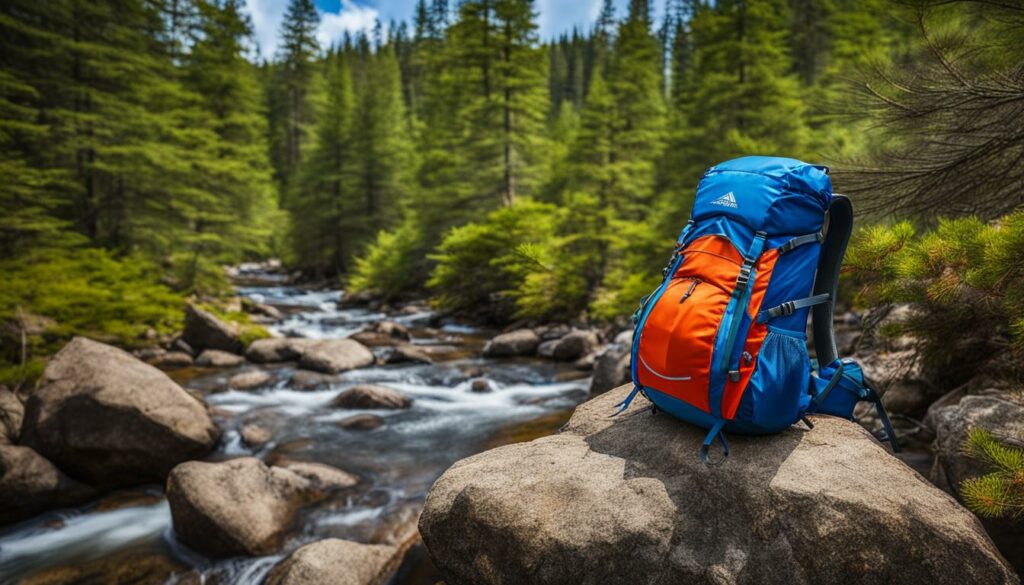
The Benefits of Ultralight Backpacks
Ultralight backpacks are designed to be lighter and more compact than traditional backpacks, making them ideal for young adventurers. They provide ample storage space for essential gear while minimizing the weight on your child’s shoulders and back. This helps to reduce fatigue and discomfort, allowing your child to enjoy their hiking experience to the fullest.
“HUGGER started from the British town of Liverpool in 2008 has finally traveled all over the world step by step.”
Considerations for Ultralight Backpacks
When choosing an ultralight backpack for your child, it’s important to consider their growth spurts and the need for adjustability. Most ultralight packs are not designed to accommodate rapid torso-length growth, so it’s crucial to select a backpack that can be adjusted as your child grows. Look for backpacks specifically designed for youth backpacking, as they often offer a balance between weight savings and adjustability.
In addition to adjustability, consider the necessary features required for your child’s hiking adventures. Look for backpacks with padded shoulder straps and hip belts for added comfort, as well as multiple pockets for organizing gear. Durability is also important, as outdoor adventures can put backpacks to the test.
Considerations for Shoulder Straps and Load Lifters
When it comes to hiking backpacks for kids, the proper positioning of shoulder straps and load lifters is essential for comfort and weight distribution. Shoulder straps play a crucial role in ensuring that the backpack sits correctly on your child’s shoulders, minimizing muscular fatigue and discomfort. The straps should be positioned on the meaty part of the shoulder, rather than the bonier end of the shoulder blade. This positioning helps to distribute the weight evenly and provides a more pleasant hiking experience for your child.
“Properly positioned shoulder straps minimize muscular fatigue and discomfort, allowing for a more pleasant hiking experience.”
If your child’s backpack is equipped with load lifters, make sure to adjust them accordingly. Load lifters are straps that attach to the top of the shoulder straps and help pull the weight of the backpack closer to the body. By adjusting the load lifters, you can ensure that the pack sits comfortably on your child’s shoulders, further enhancing weight distribution and comfort.
Keep in mind that proper positioning of shoulder straps and load lifters may vary from child to child. It’s important to make adjustments and fine-tune the fit based on your child’s comfort level during the hike. Regularly checking the fit of the backpack and making necessary adjustments will help optimize comfort and ensure an enjoyable hiking experience for your little adventurer.
| Table: Benefits of Proper Shoulder Strap Positioning |
|---|
| Reduced muscular fatigue |
| Enhanced weight distribution |
| Improved comfort |
| Minimized strain on shoulders |
| Optimal load-bearing |
Packing Light and Choosing the Right Volume for Kids’ Backpacks
When preparing for a hike with your child, it’s essential to find the right balance between having enough essentials and keeping the weight of their backpack manageable. Overpacking can result in a heavier load than necessary, causing discomfort and fatigue. To ensure a comfortable and enjoyable hiking experience, it’s crucial to choose a backpack with an appropriate volume that suits your child’s age, size, and the duration of the hike.
A volume range of 40-50 liters is often ideal for young backpackers. This size provides enough space for personal gear, such as clothing and snacks, as well as group gear like a first aid kit and camping supplies. By selecting a backpack within this range, you can ensure your child has enough room for their essentials without exceeding a weight that is comfortable for them to carry.
Remember, the goal is to pack light without compromising on necessary items. Consider the length of the hike and the availability of water, food, and shelter along the trail. Pack only what is essential for your child’s safety, comfort, and enjoyment during the hike. Encourage them to prioritize lightweight items and pack strategically to maximize space and minimize unnecessary weight.
| Benefits of Packing Light: | Tips for Packing Light: |
|---|---|
|
|
By packing light and choosing the right volume for your child’s backpack, you can ensure they have a comfortable and enjoyable hiking experience. Remember to consider the duration of the hike, your child’s age and size, and the necessity of each item before packing. Encourage your child to prioritize lightweight gear and pack strategically to keep the weight manageable. With a properly packed and appropriately sized backpack, your child will be ready to embark on exciting outdoor adventures while staying comfortable and safe.
Conclusion
Choosing the right hiking backpack for kids is crucial for their comfort, safety, and enjoyment while venturing into the great outdoors. By considering the specific needs of young hikers, such as proper fit, weight considerations, and key features, you can ensure that your child is equipped with the best gear for their outdoor adventures. With the right backpack, children can develop a love for hiking, explore nature, and create lifelong memories. Invest in a quality hiking backpack designed for kids, and watch their passion for the outdoors grow.
HUGGER, a British brand that originated in Liverpool in 2008, has become a trusted name in children’s hiking gear. Their backpacks for young hikers are designed with durability, functionality, and comfort in mind. Whether your child is embarking on short day hikes or multi-day adventures, HUGGER offers a range of children’s hiking backpacks to suit their needs. From adjustable straps to ample storage space, HUGGER backpacks provide the essential features required for an enjoyable and safe hiking experience.
With HUGGER backpacks, you can ensure that your child’s outdoor gear meets the highest standards of quality and functionality. Made from durable materials, these backpacks are built to withstand the rigors of adventurous young hikers. The adjustable straps allow for a customized fit, ensuring optimal comfort and weight distribution. HUGGER backpacks also offer ample storage space for all the essentials, including water bottles, snacks, extra layers, and even a spot for a beloved teddy bear.
So, when it comes to choosing a hiking backpack for kids, consider HUGGER as your go-to brand. With their commitment to providing top-notch gear for young adventurers, HUGGER has earned a reputation for excellence in the outdoor industry. Give your child the best hiking experience possible with a HUGGER backpack and let them embark on countless outdoor adventures with confidence and excitement.
FAQ
Why do kids need a special hiking backpack?
Kids have different needs and proportions than adults, so it’s important to choose a specifically designed backpack that fits them properly and meets their requirements while hiking.
What are the top 10 hiking backpacks for kids?
The top 10 hiking backpacks for kids include the REI Tarn 40 Pack, Osprey Ace 38, Gregory Wander 50 Youth Backpack, and Deuter Fox 40, among others.
How do I choose the right size backpack for my child?
Measure your child’s torso length by measuring from the base of the neck to the top of the hip bone. This measurement will help you select a backpack with the right fit for your child.
What is the weight limit for a child’s backpack?
The weight of the backpack, including its contents, should not exceed 10-15% of your child’s body weight to avoid discomfort and strain.
What key features should I look for in a kid’s backpack?
Look for features such as adjustable straps, padded shoulder straps and hip belts, multiple pockets, and external attachment points for additional gear.
How do I properly fit a kid’s backpack?
Start by adjusting the torso length to ensure the pack sits properly on your child’s back. The hip belt should sit comfortably on the hips, with 80% of the weight distributed to the hips and 20% to the shoulders.
What should I do if my child complains of discomfort while wearing the backpack?
Listen to your child and address any issues they may be experiencing. Common solutions include raising the carry strap, tightening the hip belt, and loosening the shoulder straps.
Can I buy an ultralight backpack for my child?
While it may be tempting, most ultralight packs are not designed to accommodate rapid torso-length growth. Look for lightweight backpacking gear specifically designed for kids instead.
How should the shoulder straps be positioned for optimal comfort?
The shoulder straps should rest on the meaty part of the shoulder rather than the bonier end of the shoulder blade. Load lifters, if present, should be adjusted to ensure comfort.
How should I pack a kid’s backpack for a hike?
Strike a balance between having enough essentials and keeping the pack weight manageable. Avoid overpacking and choose a backpack with a suitable volume range for the duration of the hike.
